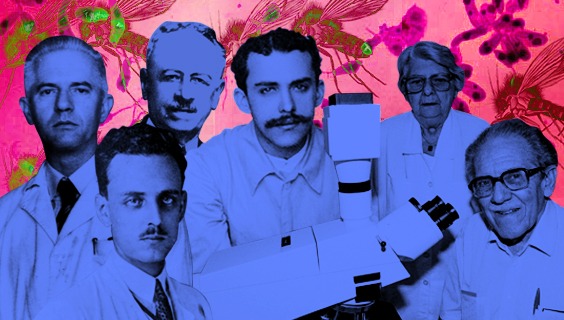 |
| Silmara Mansur |
By Glauber Gonçalves and Haendel Gomes
At the beginning of the 20th century, a set of diseases with distinct clinical manifestations represented a challenge for Pasteurian physicians, defenders of what was known as the single etiological agent doctrine. According to this theory, each disease had a specific causative agent. However, this group of tropical diseases stymieing the scientific community was caused by protozoa morphologically indistinguishable from one another using the resources available at the time.
The effort to demonstrate the existence of a new autochthonous tropical disease was also motivated by a desire return to the glory days of the Oswaldo Cruz Institute
While one of them — the Oriental sore — was of a dermatological nature, with a mild clinical progression and a tendency to disappear spontaneously, the other was aggressive. Kala-azar, in comparison, was characterized by its visceral character and rapid progression, with a high mortality rate. To accommodate this anomaly in the doctrine, a group was created in 1906 that would include these diseases, the leishmaniases, a reference to their causative agents, the leishmanias.
Over the last century, these diseases and their pathogens have been the subject of intense research and controversies that have elevated Brazil and Latin America to a position of global prominence due to their scientific research in this field. These researchers and institutions have played a predominant role in the process of globalization of tropical medicine through research on leishmaniasis and on the respective leishmanias found in these regions.
 |
| Gaspar Vianna at the Mourisco Pavilion. Photo: COC/Fiocruz Collection |
This is the argument of historians Jaime Benchimol and Denis Jogas, authors of the book Uma história das leishmanioses no Novo Mundo [A history of Leishmaniases in the New World], published by Editora Fiocruz. Based on solid, comprehensive historical research, the volume provides new evidence that challenges narratives that attribute marginal roles to non-European actors in the production of scientific knowledge during the 20th century.
The studies on leishmaniasis carried out by physician Gaspar Vianna and other Brazilian researchers who followed him are emblematic of this participation in international flows of knowledge production. The young scientist from the Oswaldo Cruz Institute was the first to describe the pathological agent of cutaneous leishmaniasis, which he named Leishmania braziliensis. The disease had attracted the attention of researchers in 1908 when an outbreak affected workers building the Noroeste do Brasil Railroad, intended to connect the states of São Paulo and Mato Grosso.
One of Vianna's main achievements was to identify which compound could be used to treat these diseases — emetic tartar (antimony potassium tartrate). Its use has saved countless lives, particularly in India, a country where kala-azar claimed many victims. Treatments based on antimony compounds, like that prescribed by Vianna, are still the principal method for treating leishmaniasis today.
Leishmania braziliensis: validation of the species was marked by disputes
Vianna died in 1914, aged 29, as a result of a tragic incident. During an autopsy, he was hit in the face by a spray of liquid contained in the chest cavity of the body of a tuberculosis patient. Shortly afterward, the scientist showed symptoms of the disease and succumbed to it. His premature death prevented him from receiving the recognition of the international scientific community during his lifetime for his description of the species.
Their use of the name Leishmania braziliensis as proposed by Gaspar Vianna and the production of archaeological evidence to support the theory that American cutaneous and mucocutaneous forms of leishmaniasis were autochthonous contributed to the growing international acceptance of the concept of American cutaneous leishmaniasis
“[Initially], no one paid attention to the [proposal of] Leishmania braziliensis. It was treated with great skepticism in both domestic and foreign medical circles," says Jogas. One of the reasons for this was the fact that the differentiating characteristic used by Vianna when proposing the species Leishmania braziliensis was incorrect: the morphological aspect that the scientist claimed made this species distinct was, in fact, present in all Leishmania. This did not prevent Leishmania braziliensis from being validated later based on other elements.
The road to this recognition, however, was long and involved the work of other Brazilian scientists. One was Alfredo da Matta, a physician from the state of Bahia. “After Gaspar Vianna's death, he undertook to publish articles in journals in a variety of countries, in which he described the types of leishmanias and the types of leishmaniasis they caused, making Leishmania braziliensis better known,” explains Jogas.
In his work, da Matta opposed French physicians who tried to establish different nomenclature for the protozoan described by Vianna: Leishmania tropica, americana variant. “Da Matta said that Leishmania tropica, americana variant was nothing more than Leishmania braziliensis in its mucocutaneous forms. His work led to new debates and advanced the process of recognition of Leishmania braziliensis,” evaluates the historian.
The attempt to obtain validation was not smooth. Illustrative of these disputes is a resounding defense of Gaspar Vianna's nomenclature by Arthur Neiva, from the Oswaldo Cruz Institute, at the Conference of the South American Society of Hygiene, Microbiology and Pathology, held in Buenos Aires in 1916. During the event, Neiva said that he was surprised by the fact that many French physicians did not accept the name Leishmania braziliensis. If so many European and Latin American researchers were unable to identify a differentiating characteristic of the species, Neiva questioned why the name defended by the French should be used, given that Vianna's proposal was earlier.
The species was validated only in 1944, 33 years after Gaspar Vianna's proposal. The consolidation was based on the work of parasitologist Samuel Pessoa, from the University of São Paulo (USP) School of Medicine. As a result of the work of a commission for the study of leishmaniasis in the state of São Paulo, which he coordinated, the physician produced a lengthy compendium on these diseases, especially those occurring in the Americas.
“Their use of the name Leishmania braziliensis as proposed by Gaspar Vianna and the production of archaeological evidence to support the theory that American cutaneous and mucocutaneous forms of leishmaniasis were autochthonous contributed to the growing international acceptance of the concept of American cutaneous leishmaniasis,” explains Benchimol.
Yellow fever paved the way for research into leishmaniasis
 |
| Evandro Chagas. Photo: COC/Fiocruz Collection |
Another important individual in the history of leishmaniasis was Evandro Chagas, Carlos Chagas's son and disciple. The physician was sent by his father to investigate the deaths identified through routine research related to the Cooperative Yellow Fever Service, which maintained a laboratory for analyzing liver fragments from victims of the disease. In 1934, in that laboratory in Bahia where material collected in the North and Northeast of Brazil was analyzed, pathologist Henrique Penna identified protozoa of the genus Leishmania.
In 1936, to support Chagas's studies on visceral leishmaniasis in the Amazon, the Northern Pathology Institute was founded in the city of Belém, Pará. “The effort to demonstrate the existence of a new autochthonous tropical disease was also motivated by a desire return to the glory days of the Oswaldo Cruz Institute, which was experiencing great uncertainty while President [Getúlio] Vargas was in office,” says Benchimol. In the previous decades, the institution — the embryo of the Oswaldo Cruz Foundation (Fiocruz) — had become notable for the discovery of Chagas disease and for the successful fight against the epidemics that plagued Rio de Janeiro, the federal capital at that time.
Evandro Chagas also led the Service for the Study of the Principal Endemic Diseases (SEGE). In that position, the scientist “reinvigorated the importance of the [Oswaldo Cruz] Institute in the State's decisions related to public health,” assesses Benchimol. However, the tragic airplane accident that killed him in 1940, over Guanabara Bay, interrupted the rise of the Northern Pathology Institute, which would later be renamed after the scientist. Studies on visceral leishmaniasis in the institute in the state of Pará, however, decelerated.
Epidemic of visceral leishmaniasis in Ceará
In 1953, a great leishmaniasis epidemic devastated the state of Ceará. The disease was initially identified in municipalities in the north of the state thanks to diagnoses made by a doctor from Sobral, Thomas Correa Aragão, and a pharmacist from Viçosa do Ceará, Felizardo de Pinho Pessoa Filho. Scientists and health authorities in the northeastern state and from São Paulo mobilized to fight and study visceral leishmaniasis, which came to be known as "kala-azar," a word used only in India and other parts of Asia until then.
After getting a degree in pharmacy, Felizardo de Pinho Pessoa Filho took over the family business: Farmácia Pinho & Irmãos. Curious and self-taught, he dedicated his time to studying the medical sciences and often put what he learned into practice to help patients. Upon examining some children from Ubari, the pharmacist suspected that they had visceral leishmaniasis. He also identified the occurrence of sandflies, insects responsible for transmitting the disease to humans, dogs and foxes. His findings then led him to alert health authorities of the outbreak.
The observation of the disease in human beings by Pessoa Filho was unusual. Since the families refused to let him perform surgery to obtain a tissue sample from the liver and spleen of those affected by the disease, he accepted a proposal from the father of one of the victims: "I will let you under one condition, said the father of Francisco. If you make sure his funeral is accompanied by a musical group and you invite many of the boys from the neighborhood, with a really nice casket," he said.
After the agreement was made, Pessoa Filho collected the material and sent it to São Paulo to Samuel Pessôa, head of the Department of Parasitology at the University of São Paulo (USP) School of Medicine, who sent the couple Leônidas and Maria Deane — former colleagues of Evandro Chagas — to Ceará. "Corroborating the findings of the pharmacist from Viçosa, the parasitologists from Pará identified the fox as a Leishmania host, confirming the wild reservoir that Evandro Chagas had sought to support the autochthonous nature of American visceral leishmaniasis and its agent, Leishmania chagasi," explains researcher Jaime Benchimol.
No one had any doubt that the epidemic was largely due to the socioeconomic conditions of rural workers
However, the other observations made in Ceará seriously undermined fundamental aspects of the theory defended by Evandro Chagas in the 1930s, according to which the visceral leishmaniasis found in South America was a disease specific to the continent, unlike kala-azar, which affected countries in Asia and Africa. “Now there was a disease that did not depend on the forests. It could occur in urban and rural areas with a focal character, with urban transmission being proven by patients and especially dogs that become infected in cities,” explains Benchimol.
In 1953, a campaign against visceral leishmaniasis was established in Ceará under the leadership of Joaquim Eduardo de Alencar, one of the founders, in 1947, of the School of Medicine in that state. He had a three-pronged attack. As in India and in other parts of the world, the disease was fought via household fumigation carried out by National Malaria Service officers. The campaign also involved the discovery and elimination of canine cases. “No one had any doubt that the epidemic was largely due to the socioeconomic conditions of rural workers. Alencar is quoted as having made a significant comment: 'Leishmaniasis is a disease of dogs and of those who live under similar conditions,'” says researcher Jaime Benchimol.
Although research indicated that prophylaxis should include improving the living conditions of affected populations, in practice it was limited to treatment with the antimonial drugs then available, especially meglumine antimoniate, provided free of charge to hospitals and health clinics.
Translated by Naomi Sutcliffe de Moraes






